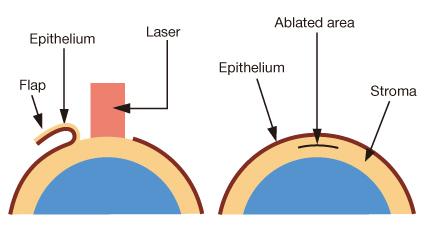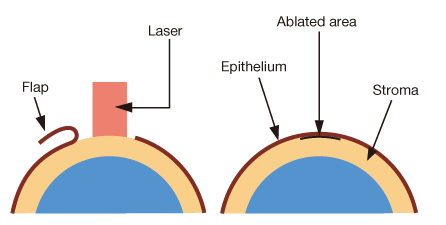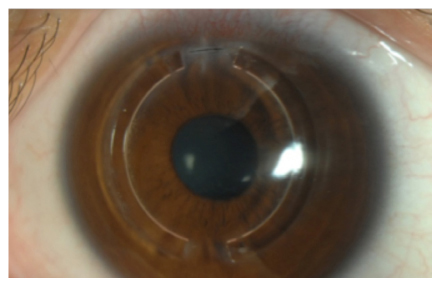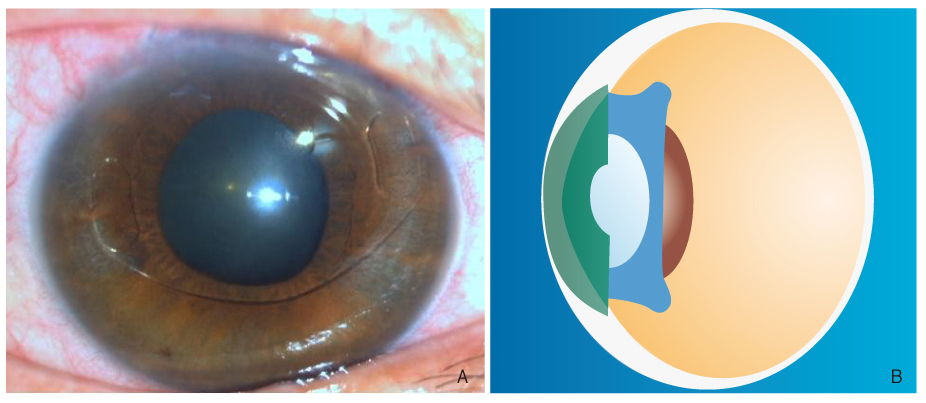J Korean Med Assoc.
2011 Apr;54(4):392-398. 10.5124/jkma.2011.54.4.392.
Surgical treatment for myopia
- Affiliations
-
- 1Department of Ophthalmology, Asan Medical Center, University of Ulsan College of Medicine, Seoul, Korea. hwtchah@amc.seoul.kr
- KMID: 2190423
- DOI: http://doi.org/10.5124/jkma.2011.54.4.392
Abstract
- This article briefly explains surgical treatments of myopia. Laser refractive surgery using the excimer laser and/or femtosecond is the most commonly operated one. As the cornea has the greatest refractive power out of the ocular structures, the laser refractive surgery ablates the corneal stroma. Laser refractive surgeries are categorized by the surgical procedures basics: photorefractive keratectomy, laser in situ keratomilieusis (LASIK), laser epithelial keratomileusis, and Epi-LASIK. There are also some surgical treatment of myopia that does not use the laser ablation of the stroma. Intrastromal corneal ring segments implantation changes corneal shape which leads to the change of refractive power. Clear lens extraction reduces refractive power of crystalline lens by removal, and phakic intraocular lens implantation adds negative refractive power by implantation of intraocular lens. Patients are recommended to have a detailed consultation before choosing the surgical treatment based on their ocular status. There are several methods to treat myopia surgically, Laser reftractive surgery on cornea is most common method currently.
Keyword
MeSH Terms
Figure
Reference
-
1. Sato T, Akiyama K, Shibata H. A new surgical approach to myopia. Am J Ophthalmol. 1953. 36:823–829.
Article2. Fyodorov SN, Durnev VV. Surgical correction of complicated myopic astigmatism by means of dissection of circular ligament of cornea. Ann Ophthalmol. 1981. 13:115–118.3. Pettit GH. The ideal excimer beam for refractive surgery. J Refract Surg. 2006. 22:S969–S972.
Article4. Lacayo GO 3rd, Randleman JB. Surface ablation. Int Ophthalmol Clin. 2008. 48:17–28.
Article5. Reynolds A, Moore JE, Naroo SA, Moore CB, Shah S. Excimer laser surface ablation - a review. Clin Experiment Ophthalmol. 2010. 38:168–182.
Article6. Trokel SL, Srinivasan R, Braren B. Excimer laser surgery of the cornea. Am J Ophthalmol. 1983. 96:710–715.
Article7. Sohn JH, Kim YJ, Tchah H. Excimer laser photorefractive keratectomy: multicenter study. J Korean Ophthalmol Soc. 1993. 34:1208–1212.8. Pallikaris IG, Papatzanaki ME, Stathi EZ, Frenschock O, Georgiadis A. Laser in situ keratomileusis. Lasers Surg Med. 1990. 10:463–468.
Article9. Moon CS, Tchah H. Results of LASIK for high myopia. J Korean Ophthalmol Soc. 1998. 39:865–871.10. Hong JT, Lee JE, Kim JY, Kim MJ, Tchah H. Clinical results of wavefront-guided LASIK. J Korean Ophthalmol Soc. 2010. 51:1438–1444.
Article11. Kim HB, Kim YS, Tchah H. Comparison of clinical results of PRK with LASIK for myopia between 3.00 & 7.75 diopters. J Korean Ophthalmol Soc. 1999. 40:2743–2751.12. Korean Society of Cataract and Refractive Surgery. Refractive surgery. 2005. 2nd ed. Seoul: Choesinuihaksa.13. Burris TE. Intrastromal corneal ring technology: results and indications. Curr Opin Ophthalmol. 1998. 9:9–14.
Article14. Huang D, Schallhorn SC, Sugar A, Farjo AA, Majmudar PA, Trattler WB, Tanzer DJ. Phakic intraocular lens implantation for the correction of myopia: a report by the American Academy of Ophthalmology. Ophthalmology. 2009. 116:2244–2258.
Article







